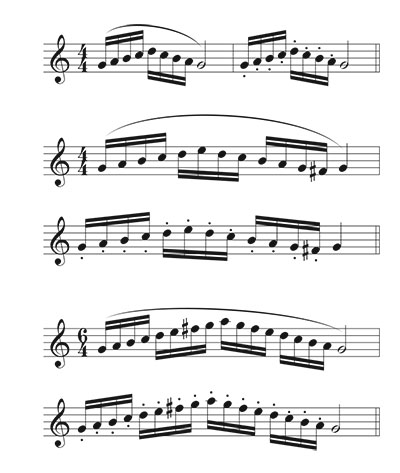Often, my students ask me how to tongue softer or harder, but the reality is that physically tonguing hard or soft is impossible. Exploring this led to additional inquiries regarding the common misconceptions of articulating the saxophone. Before the familiar fallacies associated with tonguing along can be corrected, it is important to understand that the tongue strikes the reed to stop vibrations. The sound of an articulation occurs when the tongue releases the reed, allowing it to once again vibrate. This key aspect is often overlooked.

Misconception 1:
Tip-to-Tip Tonguing
Saxophonists are often taught to tongue by touching the tip of the reed with the tip of the tongue, but this is awkward, as it requires the performer to pull the entire tongue back in their mouth to be in a position to strike the tip of the reed. In a masterclass I attended during my time as a doctoral student at the University of North Texas, I recall Eugene Rousseau saying that in his many years of teaching he has only met a handful of performers that could tip-to-tip tongue. This means that instructors have been encouraging their students to accomplish a task that is only realistically achievable by a small number of people.
In his video Sinta on Sax, Donald Sinta demonstrates his technique for discovering the portion of the tongue he uses to strike the reed. To accomplish this, he marks the reed with a black pen then articulates multiple times. He removes the mouthpiece and reed from his mouth and shows his tongue to reveal a black mark midway up his tongue, not at the tip of his tongue. This further demonstrates the faulty notion of tip-to-tip tonguing.
A better solution is to touch the blade, or tip, of the reed with a portion of the tongue that is slightly back from the tip. Each student should find the comfortable point on their tongue that is closest to the tip to strike the reed. This point will most likely be slightly back from the tip of the tongue. One can use Sinta’s method to discover the portion of the tongue being used. Use a non-toxic marker to mark a quarter-inch-long line on the tip of the reed. Tongue the reed multiple times and examine the placement of the mark on the tongue. To shift the point of contact between the reed and the tongue, students should attempt to touch the reed with either tah or loo syllables.
Misconception 2:
Tonguing Harder or Softer
A note begins by releasing the tongue from the reed. There is no gradation of removing the tongue; one either releases it or not. This eliminates the possibility of articulating harder or softer. A student whose tonguing would best be described as too hard should work to develop a consistent airstream void of any burst of air at the beginning of the note. Often, it is the attack being too loud that earns a student the label of “hard tonguer.” A consistent, controlled airstream is especially important if the student is performing a soft passage.
Alternatively, one who tongues too softly should strike the reed with a portion of the tongue closer to the tip. What sounds like soft tonguing is most likely to be an inaccurate attack caused by tonguing too far back. By touching the reed with a portion closer to the tip, the attack will be more precise and audible.
Misconception 3:
Staccato Does Not Equal Short
Staccato means disconnected or detached, but many students incorrectly see staccato marks and think “as short as possible.” In many contexts a short note is the appropriate method to produce the staccato style that the composer desires, but this is not always the case. The length of the staccato note is dependent on the tempo of the piece and the duration of the note under the staccato. If the tempo is slow and the note in question is a quarter note, then the note will have some depth. If the tempo of the piece is fast and the staccato note is a sixteenth note, then the notes will be quite short. A good rule of thumb is to teach students that a staccato note should be played as if the note was half the value. For example, if the staccato note is a quarter note, then the performed value will be one half of a beat.
Misconception 4:
I Cannot Tongue Any Faster
Students often encounter passages in the music that are beyond their current tonguing capability. However, the tongue is a muscle and, like any other muscle, it can be trained. To develop the ability to tongue faster, first examine the technique for striking the reed. The fastest method for articulating the saxophone is to strike the reed with as little tongue as possible. Students using a large area of the tongue to stop the reed between notes will struggle to articulate quickly. Once the articulation technique is correct, move to tonguing exercises. Below is an exercise to help build articulation speed.

The student should begin this exercise by performing the rhythm on the first note of any scale with a metronome set to an achievable tempo. Once successful, move the metronome up by steady increments until the maximum speed at which the student can tongue accurately is found. This exercise should be repeated daily. After daily work on this exercise, the student should notice an increase in tonguing speed.
Once articulation speed on a single pitch is attained, students should progress to finger and tongue coordination exercises. The following examples depict a routine to develop accuracy in tonguing passages with moving melodies. Each of these exercises should be transposed into all keys and span the entire range of the saxophone.

Occasionally, a passage may appear that is beyond one’s single-tonguing speed. At this point, the student must decide whether to develop an even faster single-tonguing speed or to develop double-tonguing speed. The above exercises also work for boosting double-tonguing speed. By alternating the syllables ta-ka or di-gi students can work to strengthen their double-tonguing skills.
Conclusion
Tonguing can be a mysterious aspect of anyone’s performance because it happens behind the closed embouchure, and most of the above errors originate from misinformation taught to students, who then pass it on to their students. Work to correct the above misconceptions, and saxophone section articulations will be vastly improved.






